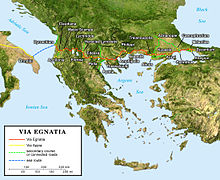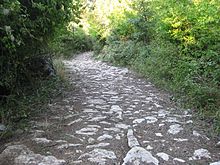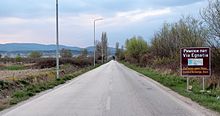
Back Eqnati yolu Azerbaijani Виа Егнация Bulgarian Via Egnàcia Catalan Via Egnatia Czech Via Egnatia Welsh Via Egnatia Danish Via Egnatia German Αρχαία Εγνατία Οδός Greek Vía Egnatia Spanish Via Egnatia Estonian
 Route of the Via Egnatia | |
| Location | Dyrrachium to Byzantium (later Constantinople) |
|---|---|
| Type | Roman road |
| History | |
| Builder | Roman Republic, Gnaeus Egnatius proconsul of Macedonia |
| Periods | 2nd century BC |



The Via Egnatia was a road constructed by the Romans in the 2nd century BC. It crossed Illyricum, Macedonia, and Thracia, running through territory that is now part of modern Albania, North Macedonia, Greece, and European Turkey as a continuation of the Via Appia.
Starting at Dyrrachium (now Durrës) on the Adriatic Sea, the road followed a difficult route along the river Genusus (Shkumbin), over the Candaviae (Jablanica) mountains and thence to the highlands around Lake Ohrid. It then turned by parts south, following several high mountain passes to reach the northern coastline of the Aegean Sea at Thessalonica. From there it ran through Thrace to the city of Byzantium (later Constantinople, now Istanbul).[1] It covered a total distance of about 1,120 km (696 miles/746 Roman miles). Like other major Roman roads, it was about six metres (19.6 ft) wide, paved with large polygonal stone slabs or covered with a hard layer of sand.[2]
- ^ Richard J. A. Talbert, Barrington Atlas of the Greek and Roman world: Map-by-Map Directory, p. 749. Princeton University Press, 2000. ISBN 0-691-04945-9.
- ^ Elena Koytcheva, "Logistical problems for the movement of the early crusaders through the Balkans: transport and road systems", p. 54 in Proceedings of the 21st International Congress of Byzantine Studies, ed. Elizabeth Jeffreys. Ashgate Publishing, Ltd, 2006. ISBN 0-7546-5740-X.